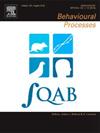消除应对的机会会导致死灰复燃
IF 1.3
4区 生物学
Q4 BEHAVIORAL SCIENCES
引用次数: 0
摘要
24只大鼠最初被训练在可变间隔30秒的食物递送时间表下按下目标杠杆。然后,在相同的时间表下,该杠杆上的反应被熄灭,而另一个杠杆上的反应被加强。最后,所有大鼠的靶反应继续消失。对于一组大鼠,灭绝也被安排为其他反应。对于两组大鼠,产生替代反应的杠杆被收回。其中一组没有食物,而另一组的食物是在可变时间安排下提供的。在所有组中,最终条件开始时目标反应的发生率超过第二条件结束时的发生率,表明复发。在最后一种情况下,目标反应的数量在去除杠杆和食物独立呈现的组中最高,在去除杠杆的组中第二高,在两个杠杆都存在但不提供食物的组中最低。这些发现表明,即使维持这种反应的刺激继续存在,消除发出操作性反应的机会也会引起死而复生。讨论了这些发现可能的临床意义。本文章由计算机程序翻译,如有差异,请以英文原文为准。
Removing the opportunity to respond induces resurgence
Twenty-four rats were initially trained to press a target lever under a variable-interval 30-s schedule of food delivery. Then, responses on that lever were extinguished and responses on an alternative lever were reinforced under the same schedule. Finally, target responses continued to be extinguished for all rats. For one group of rats, extinction was also arranged for alternative responses. For two groups of rats, the lever on which alternative responses occurred was retracted. No food was presented to one of those groups and food was presented under a variable-time schedule to the other. In all groups, the rate of occurrence of the target response at the beginning of the final condition exceeded the rate of occurrence at the end of the second condition, indicating resurgence. The number of target responses during the final condition was highest in the group with the lever removed and food presented independently of responding, second highest in the group with the lever removed, and lowest in the group with both levers present and no food delivered. These findings demonstrate that removing the opportunity to emit an operant response can induce resurgence, even when the stimulus that maintained such responding continues to be presented. Possible clinical implications of these findings are discussed.
求助全文
通过发布文献求助,成功后即可免费获取论文全文。
去求助
来源期刊

Behavioural Processes
生物-动物学
CiteScore
2.70
自引率
7.70%
发文量
144
审稿时长
4-8 weeks
期刊介绍:
Behavioural Processes is dedicated to the publication of high-quality original research on animal behaviour from any theoretical perspective. It welcomes contributions that consider animal behaviour from behavioural analytic, cognitive, ethological, ecological and evolutionary points of view. This list is not intended to be exhaustive, and papers that integrate theory and methodology across disciplines are particularly welcome.
 求助内容:
求助内容: 应助结果提醒方式:
应助结果提醒方式:


